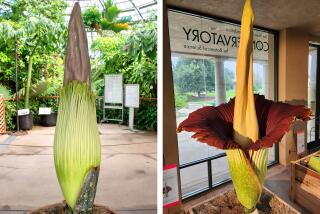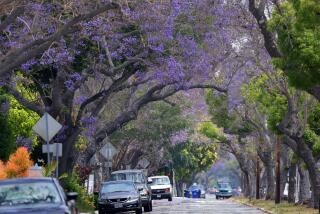Desire among the corpse flowers
It’s the sound that defines the change of season in Southern California. Low, rumbling, incessant, signaling the arrival of one wave after another of newcomers. Wagon wheels. Not the big wood ones, kicking up dust underneath Conestogas on the Old Spanish Trail. No, these are little ones, metal and rubber, rattling against parking lot blacktop at the Huntington Library and Garden in San Marino, underneath bright red Radio Flyers that ought to be pulled by, or at least carry, young children. But the wagons are being pulled by grown men and women as they hustle over pavement and lawn to get in line, three hours early, for the annual members-only plant sale.
A plant sale? Yes, a plant sale and I’ll thank you not to snicker. This is serious business. The Huntington’s annual spring sale, which was held Saturdy, is Milan and Paris to backyard gardeners. No catwalk can hold a candle to the presentation of new plant-bulbs from Madagascar, succulents from Botswana, new salvias expressing the height of the breeder’s art. Years ago, when verbena bonariensis was just a rumor to most garden enthusiasts, it was available and for sale at the Huntington. And snapped up in a minute.
So this wait in line is worth it. Even though the sale this year doesn’t have a theme, like the silver-leaved plant theme of a few years back or the year of the black flowers. A list is passed out, and a map, and it quickly becomes clear that this year’s sale includes some variety of amorphophallus, related toor possibly the same asthe notorious corpse flower, the world’s largest flower, that blooms rarely in cultivation but when it does gives off the putrid stench of rotting flesh. People in line joke about it. “That’ll keep the taggers away,” says a woman of about 70, wearing pressed blue jeans, a denim shirt, a beige gardener’s vest and a floppy straw hat.
More rattling of wagon wheels, and there’s a certain unmistakable satisfaction in the eyes of those already secure in line as they look at the next wave of gardeners pulling their Flyers in from the parking lot. That’s right. We’re ahead of you. Yes, it’s only 8:30, and the gates don’t open for another hour and a half. But we learned our lesson last time. Next time you’ll know, too.
“It’s a ritual,” says a Huntington volunteer as she checks for membership stickers on the shirts and vests of gardeners in line. “This is nothing! This is tame! It’s early yet! And when it gets started, Emily Post goes out the window. Forget manners!”
She adds, as an afterthought, “Plant people are the best.” And the people in line smile and nod in agreement, but the smiles take on a certain edge, and the nods become ever so slightly fierce. Over the lawn, past the gate and into the still-closed area where the plants are still being set up, there is a suspicious number of people with big cardboard boxes filled with plants, walking not into the sales area but away from it, with rare, precious cargo.
“Who are THEY?” ask some irritated gardeners in line, wondering what one-of-a-kind treasures are being made off with. They must be, it’s decided, volunteers, who get first crack, and may well be picking the sales area clean before the paying customers get in. Rumors start flying that there are special pre-sale pre-sales, accessible to ever more rarefied inner circles. Two men I instantly peg as enthusiasts of carnivorous plants stare intently at the activity. Almost without detection fists clench, and nerves jump at the continuing rumble of wagon wheels over concrete from new waves of grabby shoppers who will compete for one special plant or another.
I am here for pinks. Cottage pinks, cheddar pinks, Alwood pinks, or dianthus to those in the know. One year after another I have arrived at empty tables where rare dianthus used to be but were snatched by voracious, gopher-like gardeners before I could even see them. So this year I’m earlier than early, but still far from first in line.
This line stretches through the trees and out of sight, and now a second line is forming of people who are to be let in only after we in the first group are inside. People are poring over their maps, drawing circles around Latin names on the official list, leafing through their Sunset Western Garden Books. “What’s your strategy?” I hear a woman ask the man next to her, and although I don’t hear his reply I’m imagining him huffing back at her, “None of your business.” And still the rattling of more wheels. More wagon traffic. More competition.
And the gates open, and the line moves. “Go get ‘em!” says a volunteer cheerfully. And the man behind meis heyes he is! He’s trying to get ahead of me! Hold your horses, buster, I was here first, and just because you don’t have a wagon, that doesn’t give you the right to... Well, never mind. I swing my wagon a bit to the right, in a move I remember from Ben Hur. He gets the message and backs off. The swarm dividesthe carnivorous plant people one way, the cactus folks another, the rose people somewhere else. Already I see wagons filled with strange plants I’ve never seen before, and will never find on any table because they’ve already been grabbed, before I’m even fully inside. The pinks. Where are the pinks? But there are no pinks.
Barreling down on me is a smiling woman with a baby strollera double stroller, for twinstaking up the entire path between the penstemons and the salvias. As she blocks my route and reaches over my shoulder to grab some kind of salad burnet I see that one seat of the stroller contains a fussing child and the other is chockfull of plants. That’s cheating. Isn’t it? Somebody do something.
It’s too much. Too many wagons, too many grabbing hands, and no pinks. Except this one, which I probably could have gotten at any nursery. For less. But so what. My wagon and I are getting in another line now, the one for paying and getting out. I’ve got a little of this and a little of that and remember briefly that Southern California is in the midst of the driest year in decades, perhaps the driest on record, and that even if this were a wet year spring is a silly time to buy plants and set them out in the garden. Fall is planting time here. I have several years’ worth of Huntington plant tags bearing fancy names, but with only memories to go with them rather than lush exotic vegetation in the garden. “If you don’t kill a lot of plants,” the woman behind me is saying, “you’re not really a gardener.”
At the end of the line I hear a child throwing a tantrum, and I can seestanding next to his motherthe kid who formerly was in one seat of the twin stroller. His place is now taken by plants, and he’s just going to have to walk.
In my wagon is pretty muchnothing. But the bill comes in at $99.50. The sale is just getting started, and as I walk toward my car I pass more people, going the other way, their eyes filled with hunger and their hands clutching the black handles of little red wagons, rattling on the pavement.
Robert Greene is a member of The Times’ editorial board. Send us your thoughts at opinionla@latimes.com.
More to Read
A cure for the common opinion
Get thought-provoking perspectives with our weekly newsletter.
You may occasionally receive promotional content from the Los Angeles Times.











